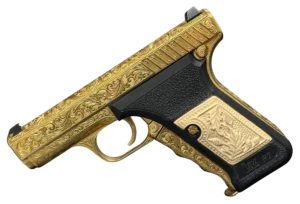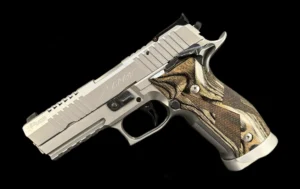This article will review the HK P7, focusing on the PSP model. The HK P7, minus the capacity of the heel-mounted mag release and the heat shield, is similar to most P7s. It can be used as a review of all P7s.
HK P7 Background
In 1976, the P7 pistol was developed in response to a request from Western police for an improved weapon after the tragedy of the 1972 Olympics. The police used a pistol and caliber that was problematic at the time. The next-generation pistol had to meet many criteria, including being a 9mm Luger, having ambidextrous operations, and being safe for carrying with a chamber loaded. It also needed to fire immediately upon drawing the gun from its holster.
In most cases, I dislike calling something “revolutionary” or “innovative,” as many people in our industry use this term excessively. That said, it is safe to say that HK designed an incredibly innovative gun for its time. They weren’t alone in the competition for the contract. The Walther P5 and the Sig P225 were also competing. The German Police adopted all three in the end. Production of the P7 started in the late 1970s and ended in the mid-2000s.
At its release, it was widely hailed as the world’s most expensive firearm. Its intricate design meant that its production cost was exorbitant. These intricate systems are what made the car so special. I’ll cover this later in this article.
It is a collectible item because it has remained in the market despite no longer being produced. This is due to its sleek design, class, rarity, and uniqueness (plus, it was an iconic piece for Hans Gruber from Die Hard). This pistol’s value has risen, and it is a good investment.
HK P7 – OUR TAKE
It’s been said that this gun should have carried 007. This statement is true. This is a classy, unique, and elegant piece. This gun is so special because it was made to make a better pistol for gunfights. This is not merely a beautiful item.
Let’s begin by examining the unique features that make this product so effective.
HK P7 Side
The squeeze cocking system built into the grip is the part of the HK P7 that stands out the most. This cocks your striker as you pull it back. The P7 won’t fire until this is fully squeezed. The P7 requires about 14 pounds in pressure, which is quite heavy. It also takes 2 pounds for the maintainer.
It may not seem like a lot, but when the P7 was released, all pistols were expected to have some form of safety. It was a clever way to create safety without needing an extra step, such as pressing a button or lever (all of which require extra coordination before you can fire). You simply grab and squeeze to fire.
It’s also even more convenient because it is the lever itself that cocks the striker. If you don’t squeeze the cocking device, the trigger will not fire. This also turns the trigger into a single action.
At first, I was somewhat confused because I had never used this firing motion. It felt a little strange to me. After a few practice sessions, I became comfortable and enjoyed it. When the slide is locked in an empty position, and the magazine has been loaded, I discovered that squeezing the cocker will send the slide back to the home position with the P7 ready for firing. It makes it much easier to reload and get back in the fight.
HK P& Slide With Piston
It is loud. It is possible to release the mechanism without making any noise. However, that’s still a little too loud.
The next thing is the recoil. This pistol has a very nice recoil, thanks to two components.
First, it has a gas piston delaying system. It works by directing some gas pressure from the firing chamber into an aperture in the frame. This pressure is then applied to a slide piston. This added force reduces the slide’s pressure to an optimal level, reducing blowback.
This system has a few drawbacks. The area around the trigger can get very hot after several magazines because of how the gas is run. The HK P7 later included a heat shield to reduce this problem. However, this is not included in my PSP (it was included in M8 models and later). After hearing from users, the heat shield does help, but it is not enough to prevent the hot trigger.
HK P7 Bore Axis
The low bore axis is another design that reduces the recoil of this gun. This is because it is the distance vertically from your top hand to the middle of the barrel—lower than the majority of pistols. It creates less muzzle-flip, which makes the P7 easier to fire and more controlled.
The P7 is extremely accurate, and this goes beyond the normal pistols.
First, we have the fixed and polygonal barrel. The barrel design allows for a low barrel because it is designed to have fewer movements. Polygonal rifling was a new feature at that time and helped with barrel wear and bullet velocity.
The 110-degree angle between the gun’s grip and its pistol is another thing that, according to HK, helps improve accuracy. According to HK, this angle is similar to the low bore axis that was previously mentioned, which supposedly allows for better pointing. Although I haven’t personally experienced it, I’ve heard other people mention that this 120-degree angle helps them with their shooting and aiming.
Last, I would like to bring up the angle at which the compact striker and magazine are inserted. The magazine is placed in a vertical position, which makes it different from most magazines. The magazine is almost perpendicular to the barrel. The bullets are chambered farther back than on most pistols. This compact striker is smaller than the majority of pistols. The gun barrel with a 6.5″ length is only 4.1″ long because of this. The bullet travels through a longer barrel in a pistol of this size.
Is There Anything Negative About the P7?
When I think of the P7’s cons, I think of two things. The slide serrations don’t have enough perforations, so it is difficult to grip and pull back the slide. It’s too heavy for my wife to use.
HK P7 Sliding Catch Button
Second, the location of the slide-catching button. This is likely a result of how I hold the P7; however, after several magazines, that button would rub and chafe the skin on the index and thumb. The edge has been rounded off for the same reason. However, I have still experienced irritation in that area of my hands after repeated use.
I would not give the P7 a high rating in terms of reliability. Although it is highly reliable in its immediate use, its many complex and intricate systems can cause problems with the weapon’s longevity.
The price is another thing that many could be unhappy about. The pistol was touted as the most expensive on the market when it first appeared. Due to their rarity and popularity, the price and value of these guns have steadily increased over time. It is difficult to give a score on something like this. It is hard to grade the current P7 value. I think it’s worth its price, but I would not argue with someone saying this gun is overpriced. A second thing that I would like to mention is the fact that the value of the weapon has increased steadily over time. I believe the value of the P7 will not decrease with use. If you bought a P7 today and sold it ten years later, you would most likely have made a profit. Isn’t this a great ROI? This is why I will give it high marks on value since this component only grows over time.
The final grade and thoughts: I love this weapon. It is incredibly designed and amazing to use. It is beautiful and iconic. The price is a little high, but it’s worth every penny. It is my go-to gun for date nights and everyday use. Every time I store it in my safe, I must dab it with oil to prevent rust. It’s worth the money. While some guys purchase a Rolex watch, I purchased an HK P7. That’s fine with me.












